10F2 Science
Section outline
-
-
Student ability to show their understanding of the basic processes by which genetic information is passed from one generation to the next, and patterns in the inheritance.
-
-
Week 1: Short week
- Welcome back to 2020. My name is Mrs Williamson and I will be your science teacher for part of the first term.
- I can be contacted on lwilliamson@mhjc.school.nz if you need to email me at any time.
- We have an exciting term planned and I look forward to getting to know you all.
Context this term is: The Game Changers
- In science, to link in with the context, we will be learning about acids and bases and their role in chemistry.
- I have added the Google Slides that we discussed in class today.

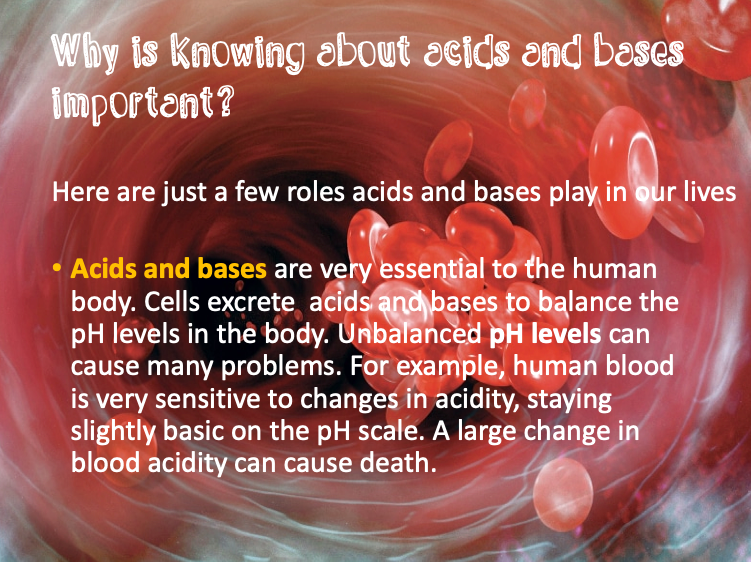
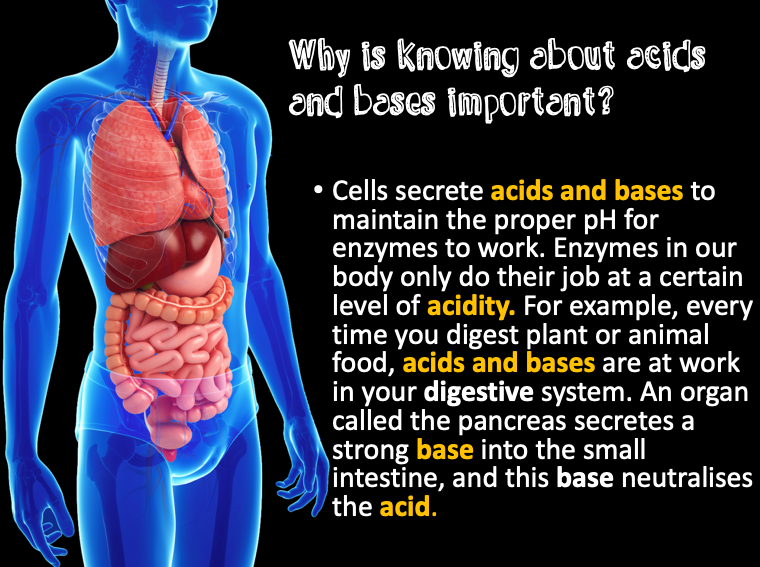
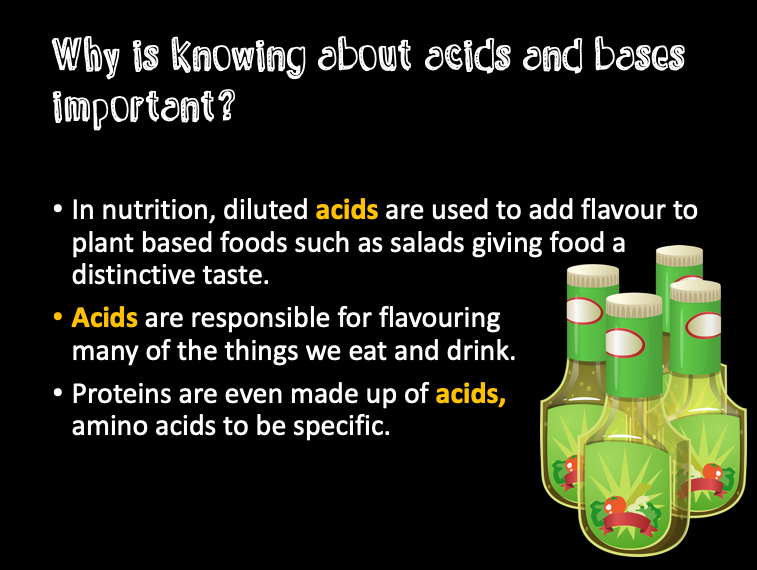


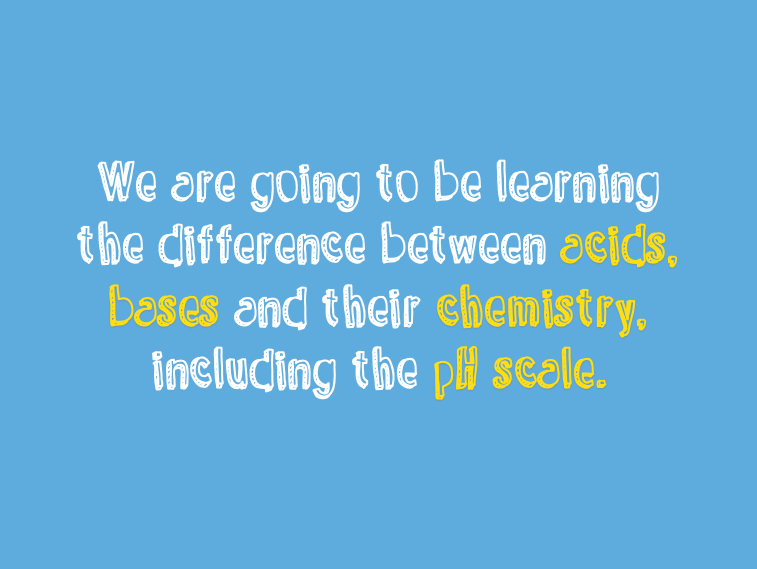
-
Week 2: Lab safety
Learning intentions:
- Is week we will spend a lesson or two getting to know each other and learn about Science Lab Safety.
- Why is it important for both students and adults to follow lab safety rules?
Success criteria:
- I understand the lab safety rules and the importance of them.
- I have written these rules down, read them and signed my agreement with my Science Teacher.
- I know where the safety bucket is (for breakages and spillages) and can locate the fire extinguisher.
-
Week 3: Continuation of last week checking in on our learning before learning about acids and bases.
Success criteria: This week we have been focusing our learning on the Periodic table and reflecting on past knowledge to ensure we have enough knowledge to guide us into learning acids and bases.
Learning objectives: To move forward with acids and bases I need to know the following
- The arrangement of the first 20 elements on the table plus the another 10 key elements.
- How to read the periodic table - atomic number, mass number, protons, neutrons and electrons,
- How to find the groupings - metals, non-metal, alkali metals, alkaline metals, transitional metals, halogens, noble gases, semimetals (metalloids) etc.
- Understand periods (rows - run horizontally) and groups (columns - run vertically).
- Understand how to draw the atomic structure and electron arrangement for the first 20 elements (drawing, table format and how to write a paragraph)
- Atoms are electrically neutral and what this means
Activities:- Developed a table of elements
- Developed an understand of how electrically neutral atoms become charged ions
- Explain how atoms become ions using different strategies - tables, paragraphs, atomic structures and electron arrangements.
- Constructed paragraphs using the NCEA writing criteria for science using the three keywords - describe, explain and discuss.
- Reflected on our learning supporting this with Education Perfect activities.
- Watched Video clips

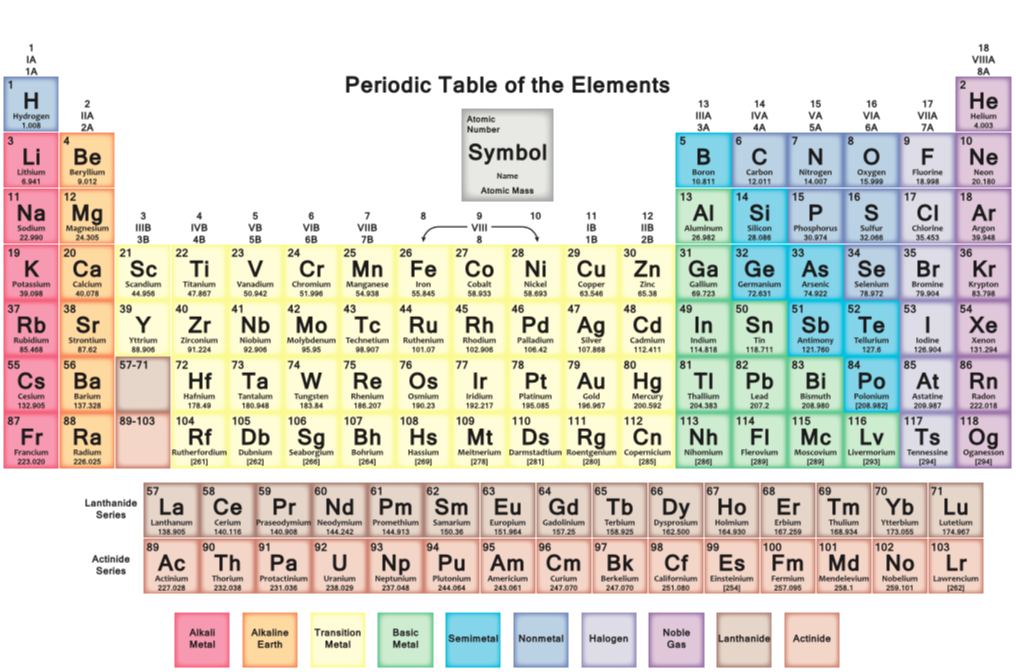


Note:
- From the Periodic table and our learnings about atoms and elements, we have now moved onto understanding the role of ions.
- It is very important that you can complete the success criteria set out below, and understand the keywords.
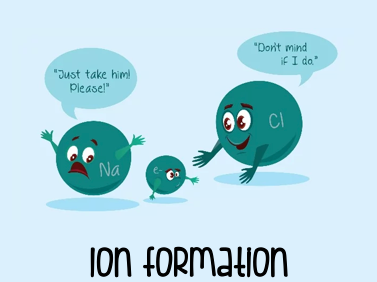
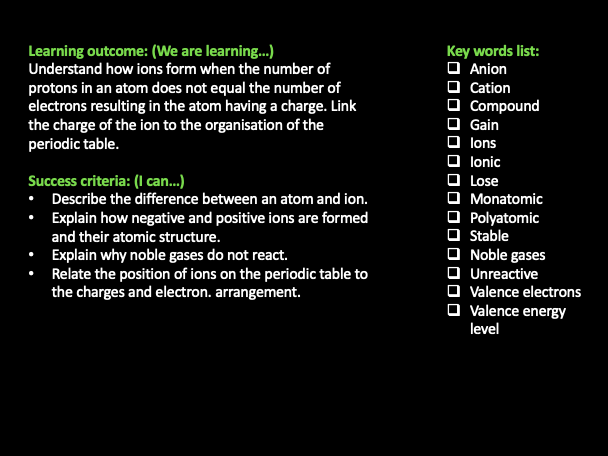
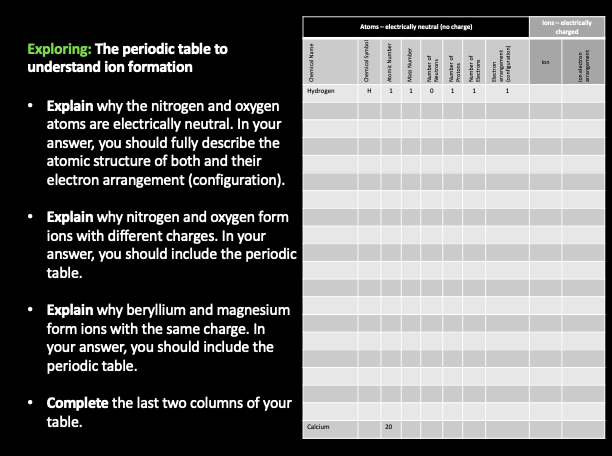
Homework:
- Incredible week you are an amazing team. Please complete any unfinished work for homework.
- If stuck I am here to help, so please just ask. Education Perfect tasks have been set for you.
- To see me if you are stuck with any tasks. Don't put if off, take ownership of your learning.
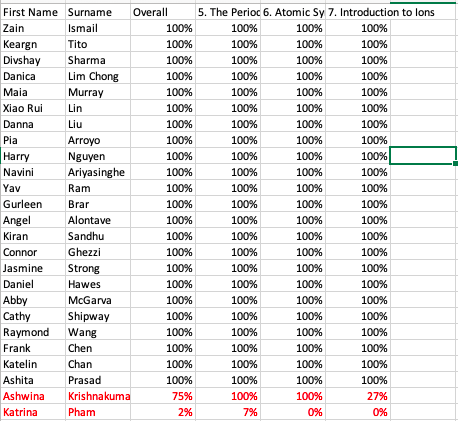
-
Week 4: This week we are continuing with our learning objectives and success criteria from the previous week. More specifically we are learning about ionic compounds, and counting atoms.
Learning intentions: Continuation form last week
- Understand how ions form when the number of protons in an atom does not equal the number of electrons resulting in the atom having a charge. Link the charge of the ion to the organisation of the periodic table.
Success criteria:
- Describe the difference between an atom and ion.
- Explain how negative and positive ions are formed and their atomic structure.
- Explain why noble gases do not react.
- Relate the position of ions on the periodic table to the charges and electron. arrangement.
Activities:- Explored the reaction between steel wool and battery investigation and discussion
- Summarised key words to assist our learning going forward - e.g. matter, atom, element, molecule and compounds
- Developed an understanding of how to name ions and ionic compounds
- Developed an understand of counting the number of atoms in an ionic compound.
- Explored common ions and how to use a table to help us in our learning.
If you are absent from science:
- If you away make sure you collect the worksheets from me and see me for explanations.
Remember:
- To keep your work tidy as this will help you for your end of year revision.
- To see me if you are stuck with any tasks. Don't put if off, take ownership of your learning.
Homework
- Please complete any unfinished work for homework.
- If stuck I am here to help, so please just ask.
- Education Perfect tasks have been set for you.
- Homework Summary (37 minute Education Perfect Homework) set for the week ended 1 March.
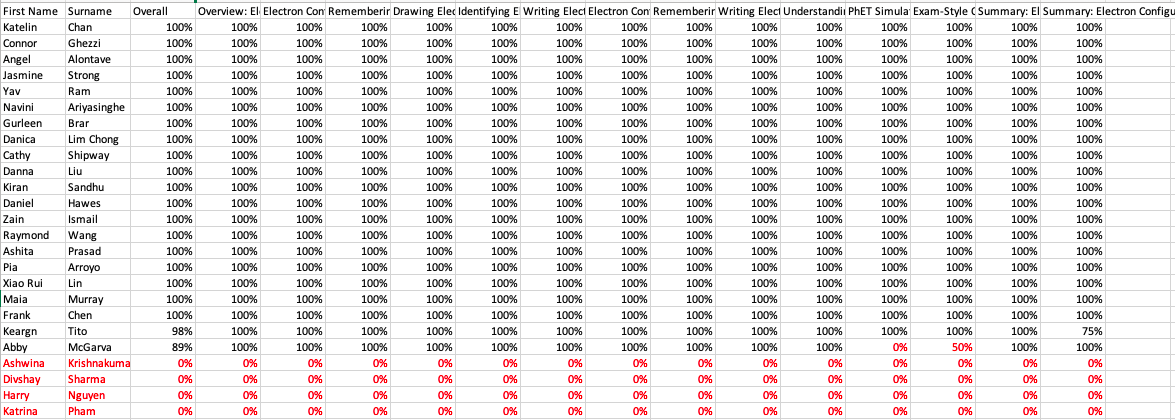

Homework: Please complete any unfinished work for homework. If stuck I am here to help, so please just ask.
Education Perfect tasks have been set for you.If you are absent from science: If you away make sure you collect the worksheets from me and see me for explanations.
Remember: To keep your work tidy as this will help you for your end of year revision.
Have you done your homework? Class code is
If your name is on the list below - you have not completed Education Perfect.
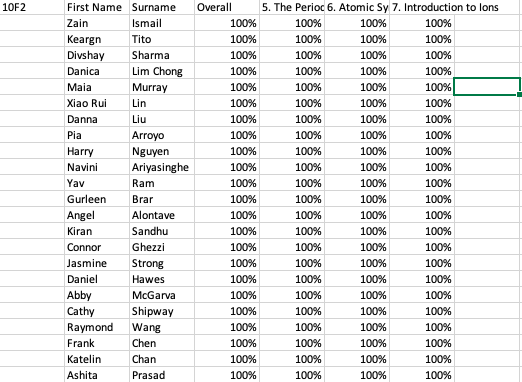
-
Week 5: This week we started learning and understanding acids and bases. (Some of the Year 10's away on camp)
Learning intentions:
We are the chemistry behind acids and bases by comparing, contrasting, experimenting and classifying their properties.
Success criteria:
- Classify acids and bases as chemicals with distinct properties and uses
- Name common acids and alkalis in the home and laboratory
- Describe the difference between a concentrated and dilute acid or base.
- Use the pH scale to compare the acidity and alkalinity of different solutions
- Use indicators to classify solutions as acidic, alkaline, or neutral
- Classify solutions as acidic, alkaline or neutral, using pH values.
- Observe and explain the process of neutralisation (acid and base reaction).
- Observe and explain the process of an acid and carbonate reaction.
- Describe some everyday uses of acids, alkalis and neutralisation.
Activities:- Understanding properties to be able to classify acids and bases.
- Internet searching a variety of acids and bases used around us and in the laboratory.
- Discovered difference between dilute and concentrated acid and base solution.
- Explored range of indicators commonly used to test pH.
Homework:- Complete all tasks required on the slides. If you have been at camp you can use Google to help you.
- No Education Perfect Homework this week due to school camp. This will be set next week.
- If you are absent from science: If you away make sure you collect the worksheets from me and see me for explanations.
- Remember: To keep your work tidy as this will help you for your end of year revision.
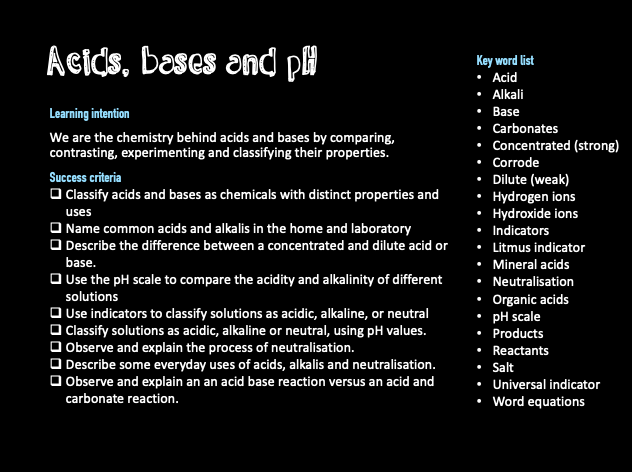

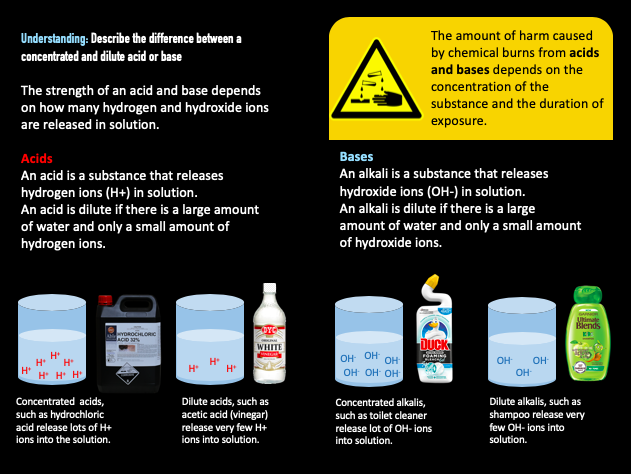
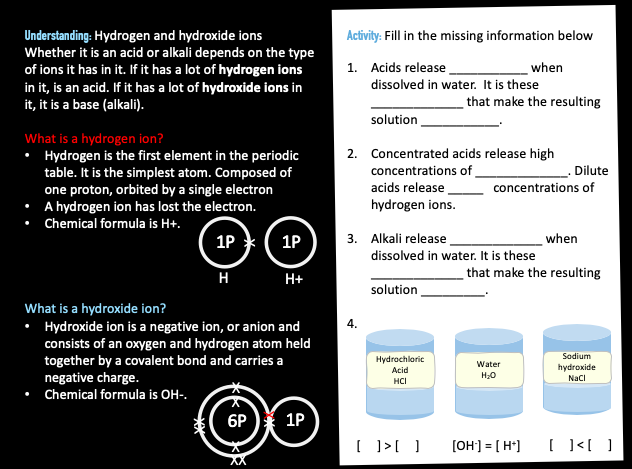
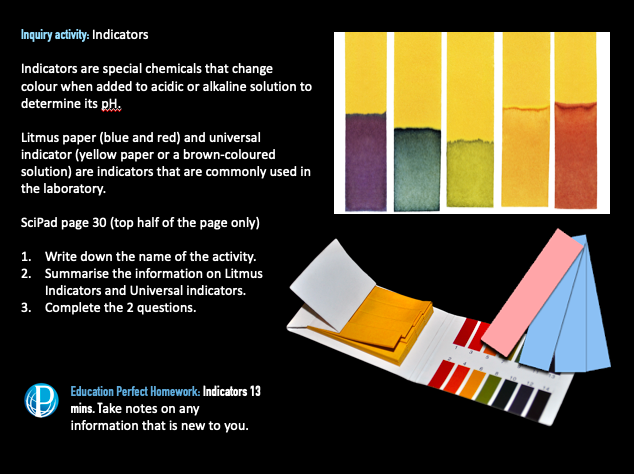
-
Week 6: This week continue our learning about acids and bases.
Learning intentions: As above
Success criteria: As above
Activities:
- Practical investigation: Acid concentration
- Understanding: Dilute, concentrated, weak and strong
- Exploring indicators and the pH scale.
- Practical investigation: Testing the pH of a range of household products
- Check in on learning activity
Homework:
- Education Perfect: Approx 40 mins total (1. Acid and base solutions 25 mins 2. pH scale and indicators 12 mins) due Sunday 3pm
- Complete any unfinished classwork.
- If you are absent from science: If you away make sure you collect the worksheets from me and see me for explanations.
- Remember: To keep your work tidy as this will help you for your end of year revision.
-
Week 7: Your assessment will start later this week.
Learning intentions: As above
Success criteria: As above
Activities:
- Understanding the pH scale
- Watching Youtube video - The pH scale
- Researching online and discussing H+ and OH ions in relation to pH scale
- Checking in with our learning
- Practical investigation: Part A - Assessment
Homework:
- Education Perfect:
- Complete any unfinished classwork.
- If you are absent from science: If you away make sure you collect the worksheets from me and see me for explanations.
- Remember: To keep your work tidy as this will help you for your end of year revision.
- Note: All class slides are not shown here, this is to encourage you to take notes and self manage your time well in class.
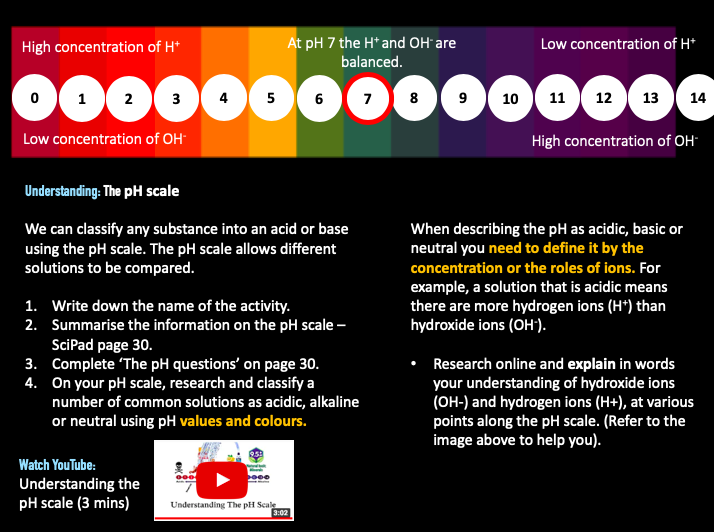
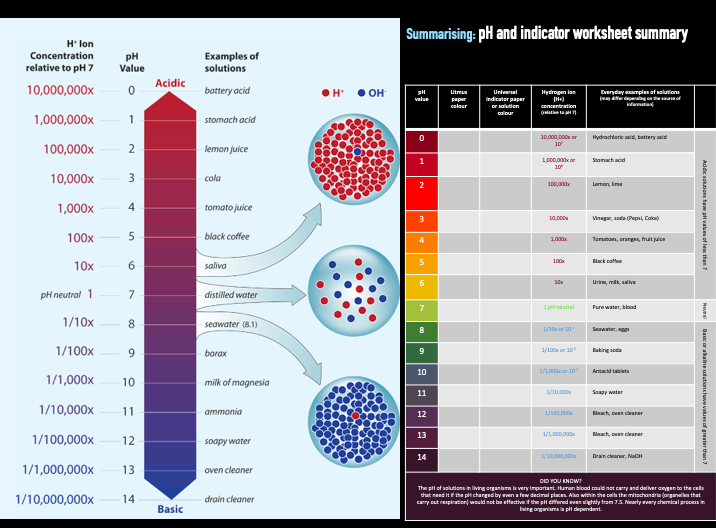

-
Week 7: This week you have your assessment to complete. It is due Saturday 10am.
Learning intentions: As aboveSuccess criteria: As above
You assessment notes can be found on MHJC.
Activities:
- Writing your answers to Parts A (Practical Investigation), Part B (Understanding the pH scale) and Part C (Deeper Thinking - which I have not posted yet) for your assessment
- It is critical that you read and understand your assessment document.
- It is critical that you read and understand your Science Writing Document
Homework:
- Completing your assessment.
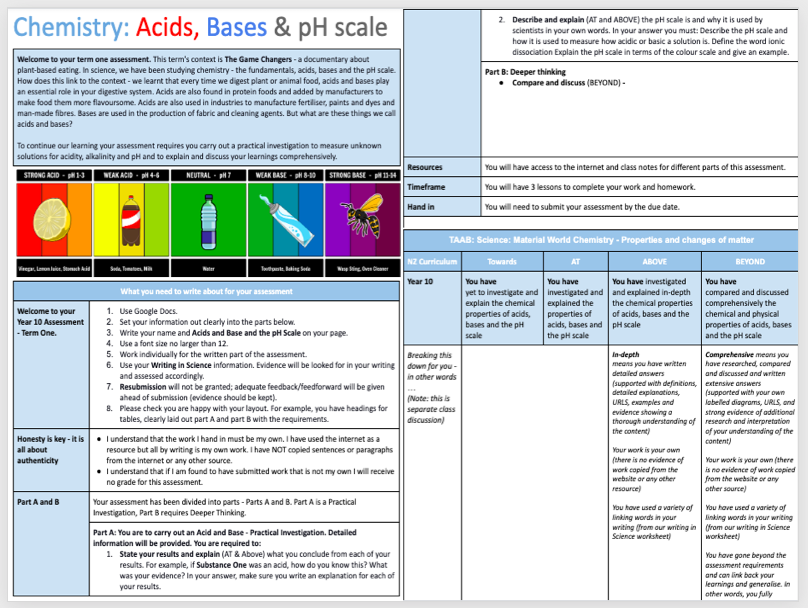
Also handed out in class were the following documents for you to complete. This may help in your assessment. Please glue them into your books.

Remember: If we need to work from home at any stage, I will keep posting a summary here what we do each week, but we will work as a class from Google Classrooms - then we can talk and communicate with each other. We are on the home straight in science. You have worked so hard this term - well done!-
Student ability to compare and discuss the chemical and physical properties of acids, bases and the pH scale.
-
Welcome to Week 1
Welcome back and I hope you had a great break.
We are trying to run a normal class timetable and this week I will be online for the beginning of each session. Please go to Google Classrooms for your classwork and check your emails for joining Google Hangouts.
Our learning is continuing on from where we left off prior to the holidays. See you online, and don't forget you can email me. I am still marking assessments and will give you feedback later today as to ones I am still missing.
Mrs Williamson
-
Term 2, Week 2
We are trying to run a normal class timetable and I will be online for the beginning of each session. Please go to Google Classrooms for your classwork and check your emails for joining Google Hangouts.
Our learning is continuing on from where we left off prior to the holidays.
This week we are looking at how acids can impact our communities.
Mrs Williamson
-
Term 2, Week 3
This week, please look out for our class meeting times, you will receive an email from me. We may not meet every session, as you will have work to complete.
This week you should aim to
- complete all your notes from Google Classroom and the SciPAD online activities for this term.
- any resubs must be in this week. You must communicate with me on your resubs, please don't make me chase these up.
Mrs Williamson -
Term 2, Week 4
This term in Science, we are starting our new context Genetics Evolution & Tino Rangatiratanga
Tino Rangatiratanga is a Māori term for self-determination, control and decision making.
So.. how are we going to apply this to Science?
- Tino Rangatiratanga is being able to make choices, big and small, about things that matter to us, as well as having the control to shape the direction and conditions of our life is fundamental to the good life.
- Over the next few weeks, we are going to apply this by making choices about our learning, and keeping up to date with our Science as this is going to help shape the direction for this year and next year when you enter into college.
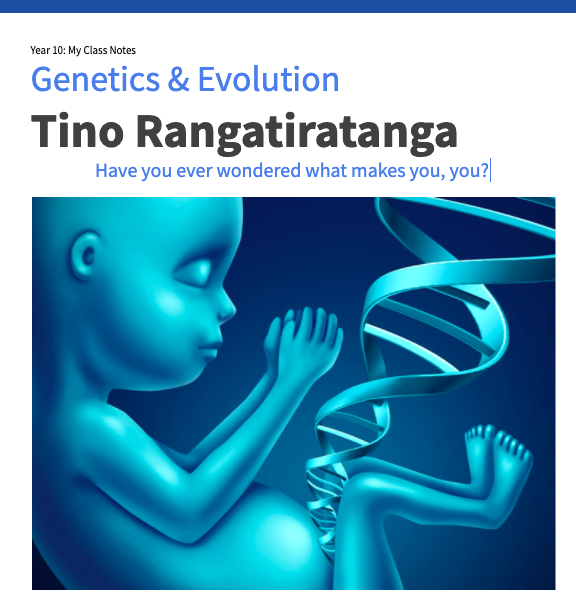

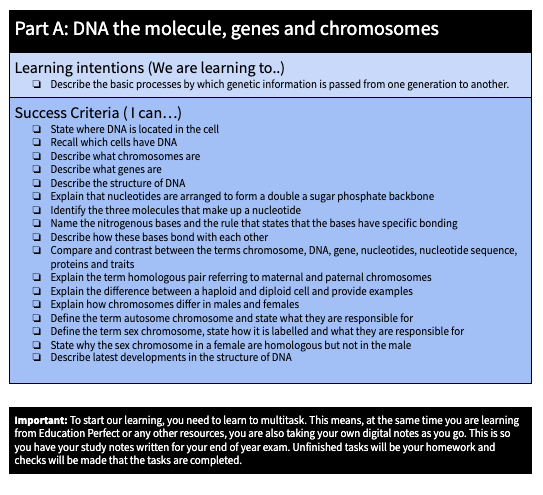

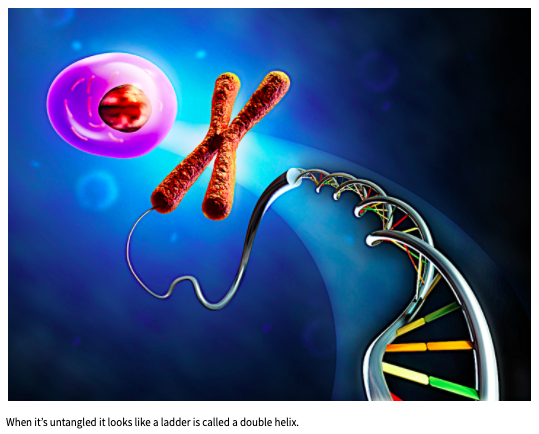

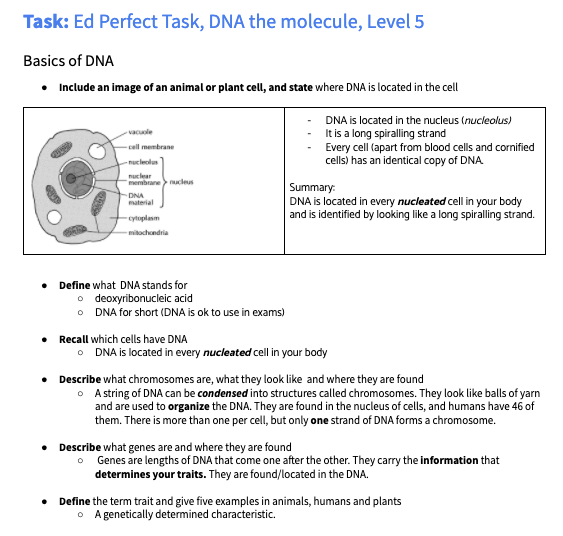
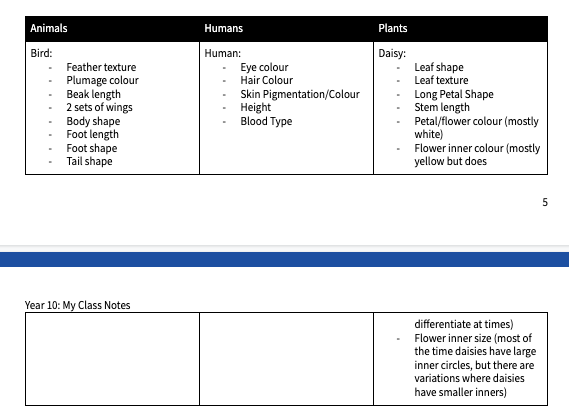


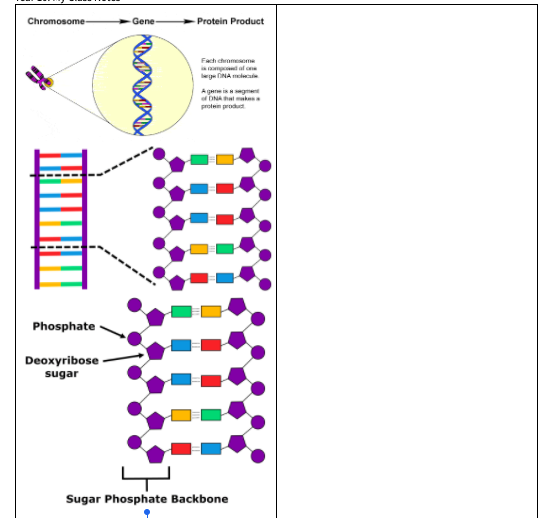
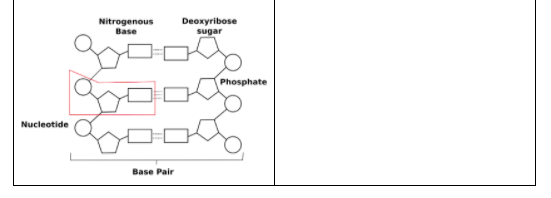
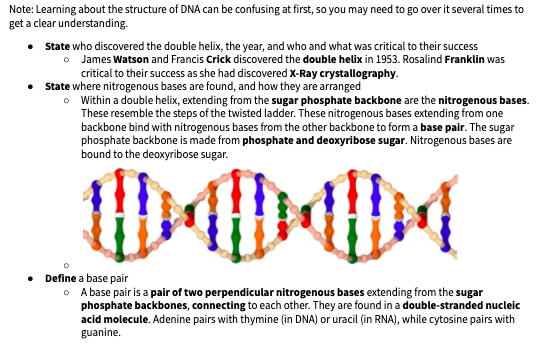

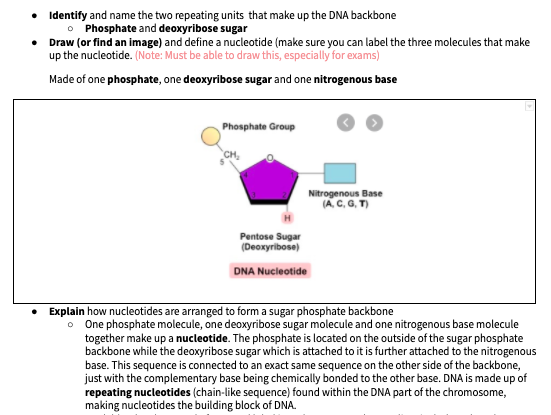
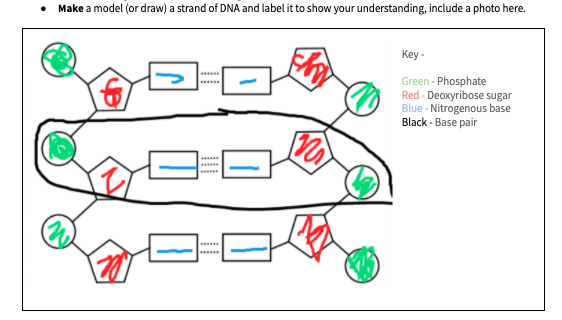
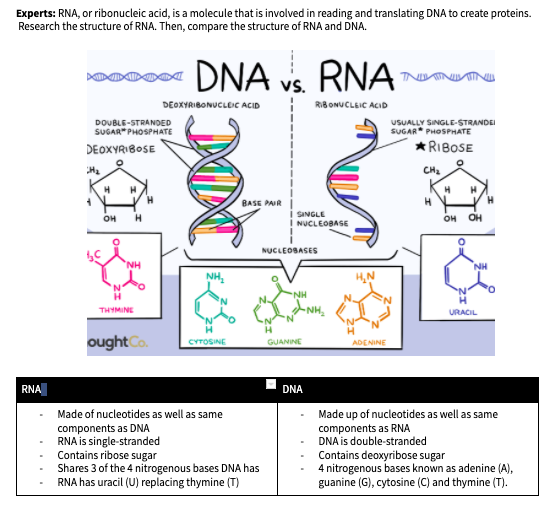
-------------------------------------------------------------------------------------------------------------------------------------------EXPLORE / TŪHURA learning intentions:
- We are EXPLORING...the basic processes by which genetic information is passed from one generation to another.
FOCUS / ARONGA learning intentions:
- We are FOCUSING...our learning on developing an understanding of genetics and how information is passed from one generation to another.
- We are FOCUSING...our learning on defining, explaining, comparing and contrasting key genetic terms.
- We are FOCUSING...our transforming our knowledge to a digital learning platform.
REFLECT / WHAIWHAKAARO learning intentions:
- We are REFLECTING...at various stages to assess and critique our knowledge - more importantly to ensure we can make connections and understand the context with the view of highlighting issues/gaps in learning as early as possible
-
Term 2, Week 5
Learning intentions: As per week 4
Success criteria: As per week 4
Activities:
- Exploring genetics
- Developing an understanding of key genetic terms
- Completing Education Perfect tasks
- Watching Youtube videos
- Applying our knowledge and practising how to write to describe and explain questions
- Sharing our work with our peers
- Collaborating as a class as we work together
- Learning how to take digital notes

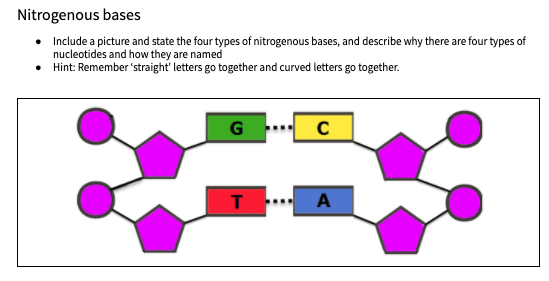
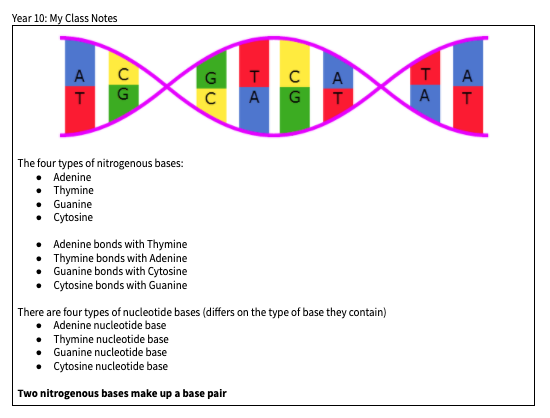
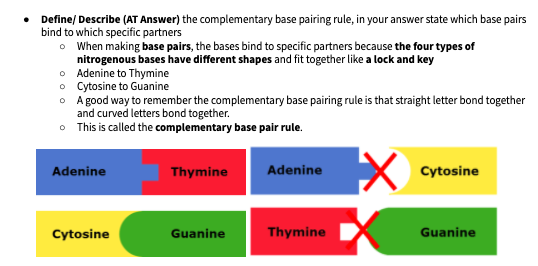


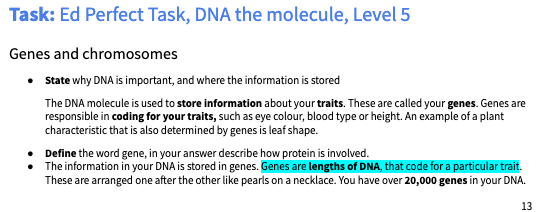
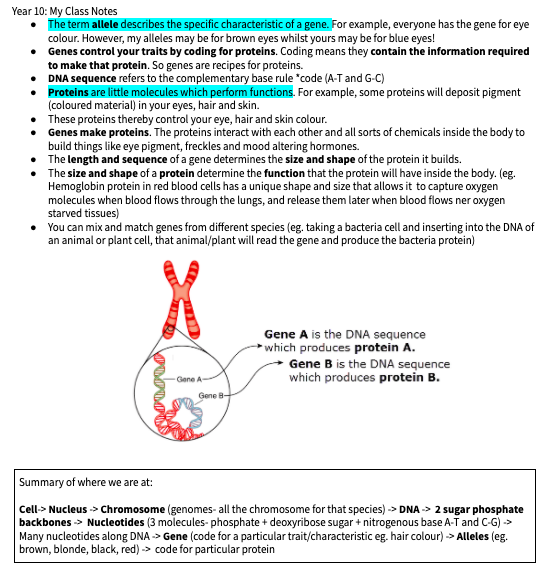
------------------------------------------------------------------------------------------------------------------------
EXPLORE / TŪHURA learning intentions:
- We are EXPLORING...the basic processes by which genetic information is passed from one generation to another.
FOCUS / ARONGA learning intentions:
- We are FOCUSING...our learning on developing an understanding of genetics and how information is passed from one generation to another.
- We are FOCUSING...our learning on defining, explaining, comparing and contrasting key genetic terms.
- We are FOCUSING...our transforming our knowledge to a digital learning platform.
REFLECT / WHAIWHAKAARO learning intentions:
- We are REFLECTING...at various stages to assess and critique our knowledge - more importantly to ensure we can make connections and understand the context with the view of highlighting issues/gaps in learning as early as possible.
-
Term 2, Week 6
Learning intentions: As per week 4
Success criteria: As per week 4
Activities:
- Exploring genetics
- Developing an understanding of key genetic terms
- Completing Education Perfect tasks
- Watching Youtube videos
- Applying our knowledge and practising how to write to describe and explain questions
- Sharing our work with our peers
- Collaborating as a class as we work together
- Learning how to take digital notes
Sample of a student's class notes




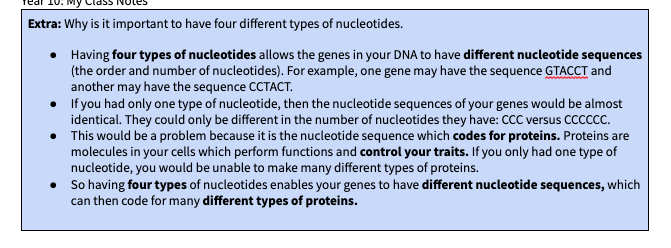
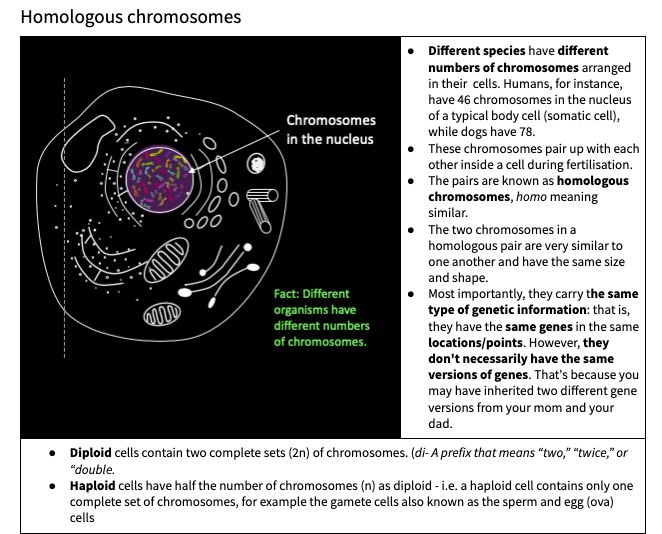
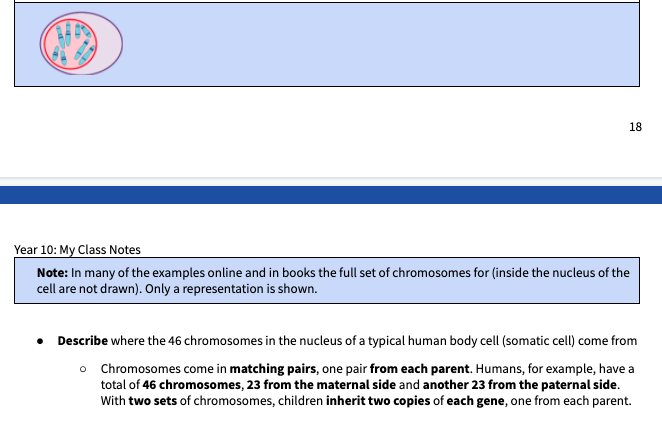
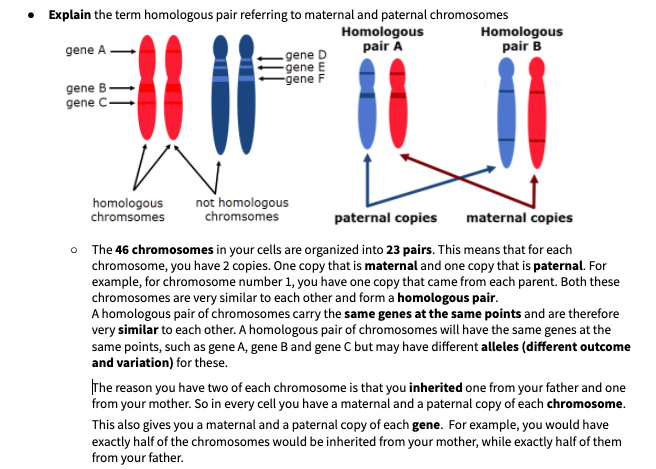

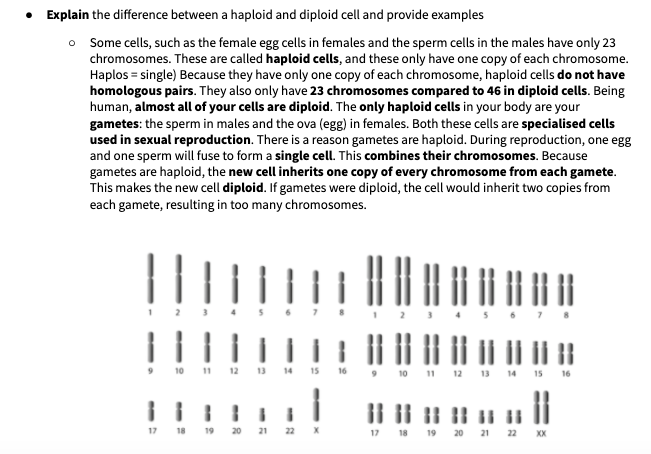

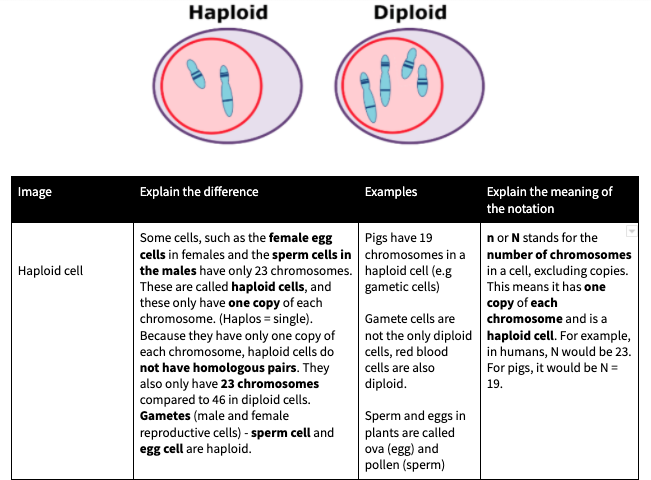

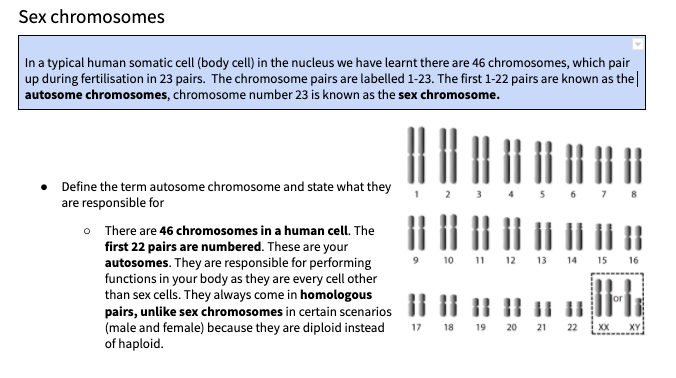
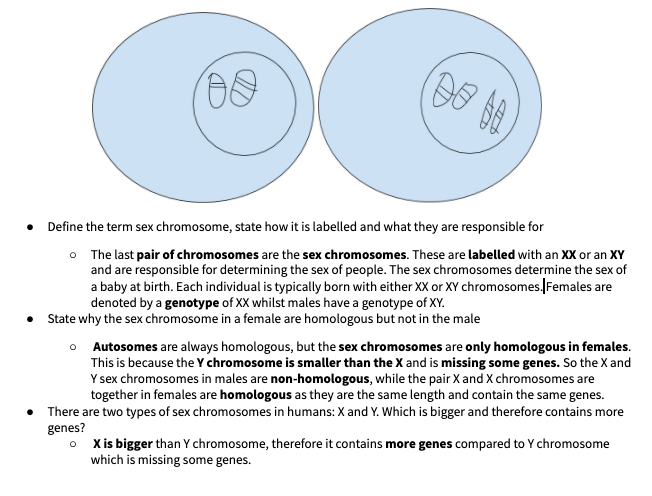

---------------------------------------------------------------------------------------------------------
EXPLORE / TŪHURA learning intentions:
- We are EXPLORING...the basic processes by which genetic information is passed from one generation to another.
FOCUS / ARONGA learning intentions:
- We are FOCUSING...our learning on developing an understanding of genetics and how information is passed from one generation to another.
- We are FOCUSING...our learning on defining, explaining, comparing and contrasting key genetic terms.
- We are FOCUSING...our transforming our knowledge to a digital learning platform.
REFLECT / WHAIWHAKAARO learning intentions:
- We are REFLECTING...at various stages to assess and critique our knowledge - more importantly to ensure we can make connections and understand the context with the view of highlighting issues/gaps in learning as early as possible.
-
Term 2, Week 7
Learning intentions: See below
Success criteria: See image below
Activities:
- Exploring two types of cell division
- Developing an understanding of key terms
- Completing Education Perfect tasks
- Watching Youtube videos
- Applying our knowledge and practising how to draw the stages of cell division
- Sharing our work with our peers
- Collaborating as a class as we work together
- Learning how to take digital notes
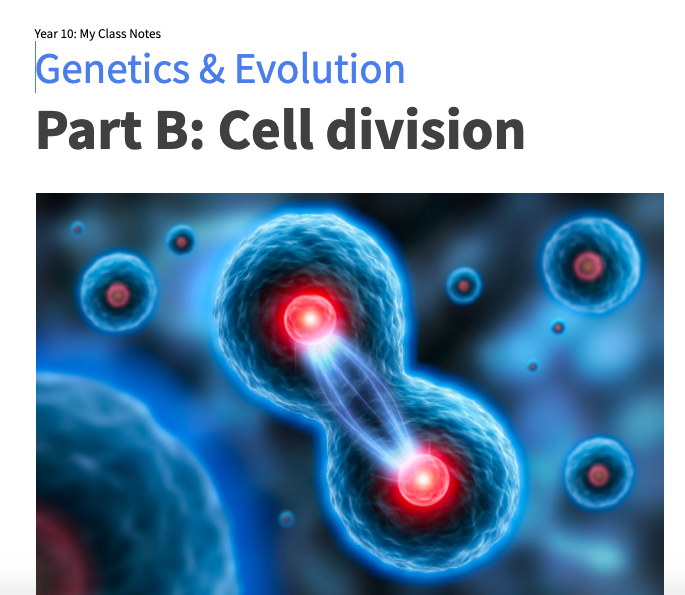
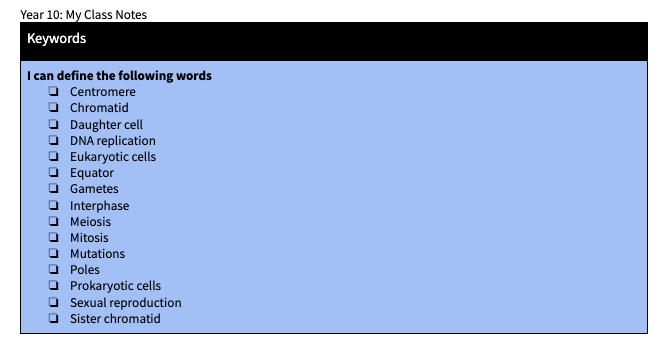
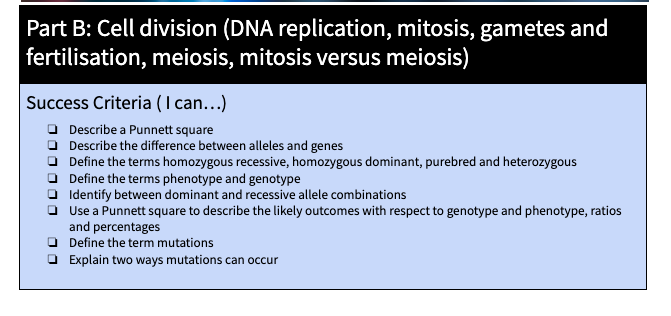
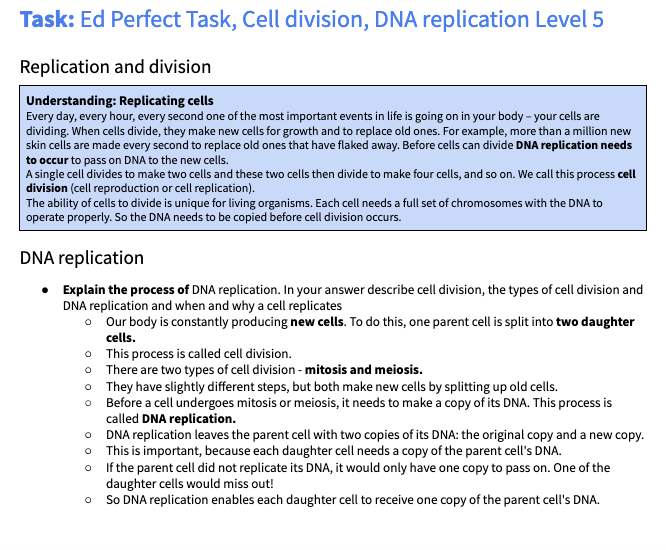

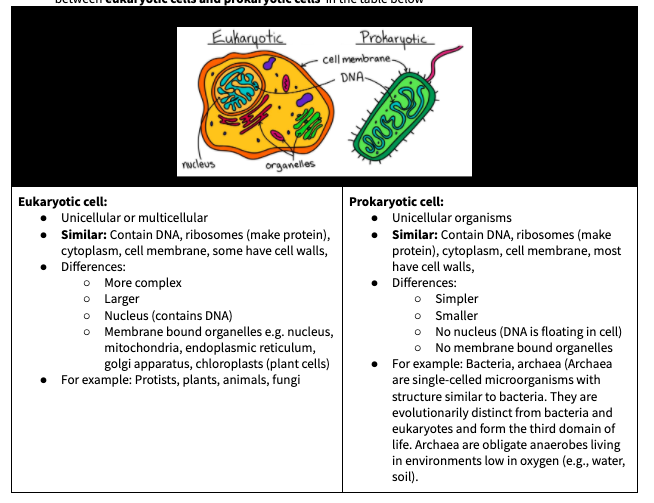

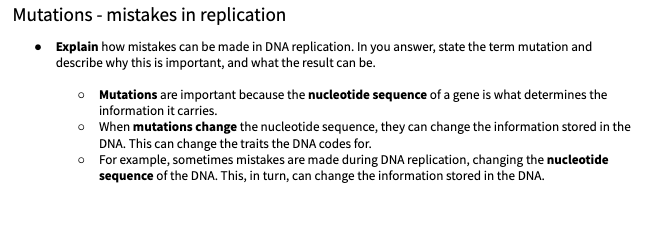

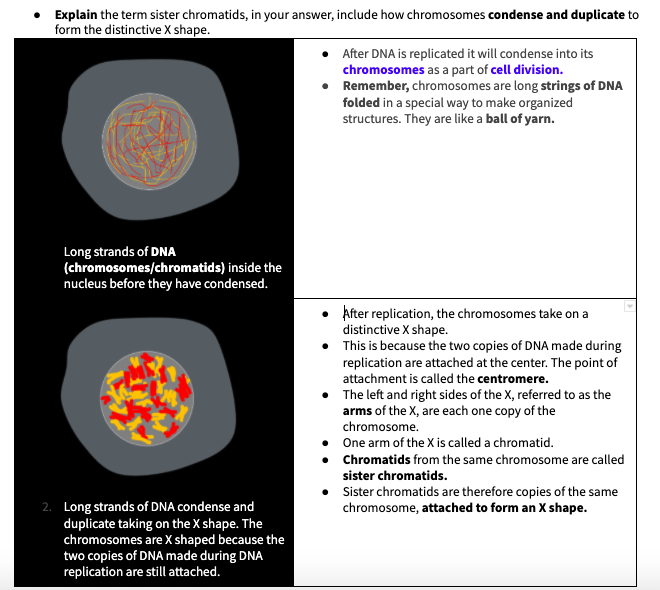

-----------------------------------------------------------------------------------------------------------------------------------------
EXPLORE / TŪHURA learning intentions:
- We are EXPLORING...the basic processes by which genetic information is passed from one generation to another.
FOCUS / ARONGA learning intentions:
- We are FOCUSING...our learning on developing an understanding of genetics and how information is passed from one generation to another.
- We are FOCUSING...our learning on defining, explaining, comparing and contrasting key genetic terms.
- We are FOCUSING...our transforming our knowledge to a digital learning platform.
REFLECT / WHAIWHAKAARO learning intentions:
- We are REFLECTING...at various stages to assess and critique our knowledge - more importantly to ensure we can make connections and understand the context with the view of highlighting issues/gaps in learning as early as possible.
-
Term 2: Week 8
Learning intentions: See week 7
Success criteria: See week 7
Activities:
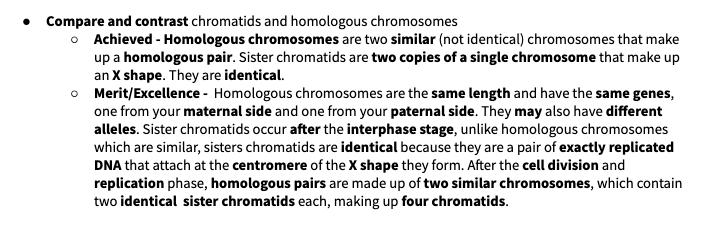
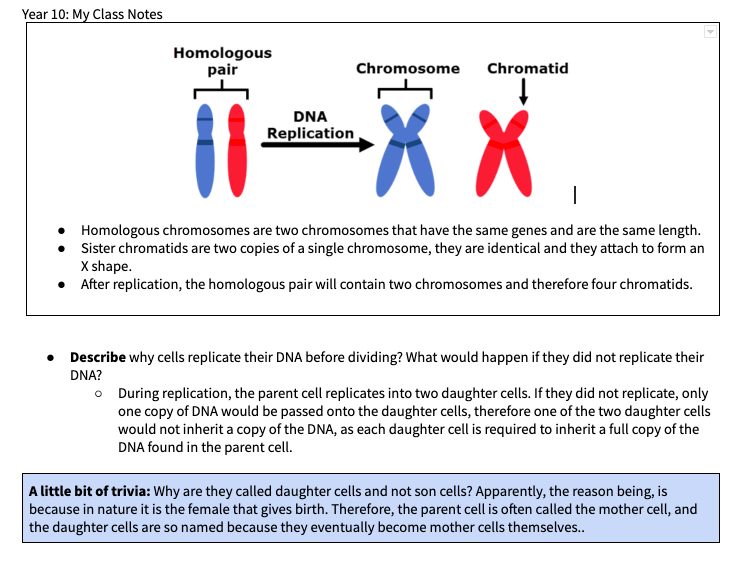

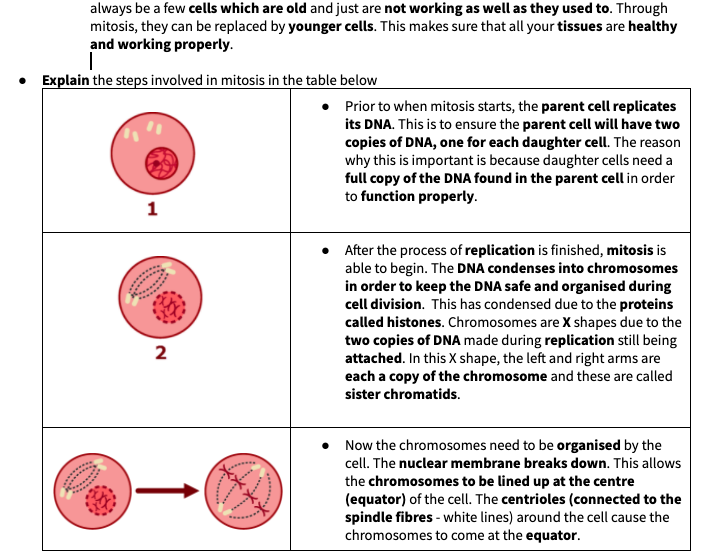

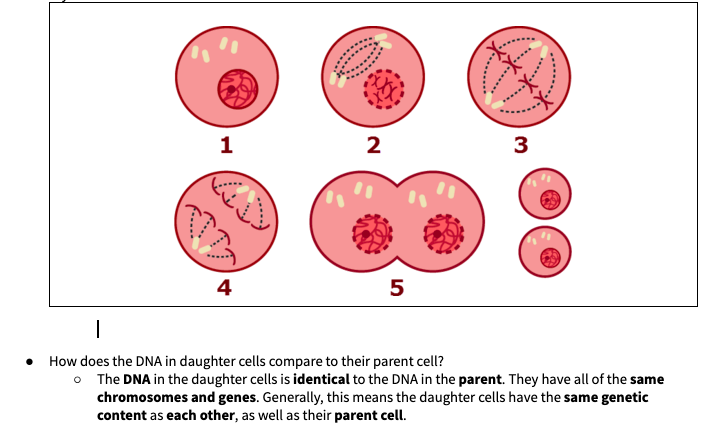


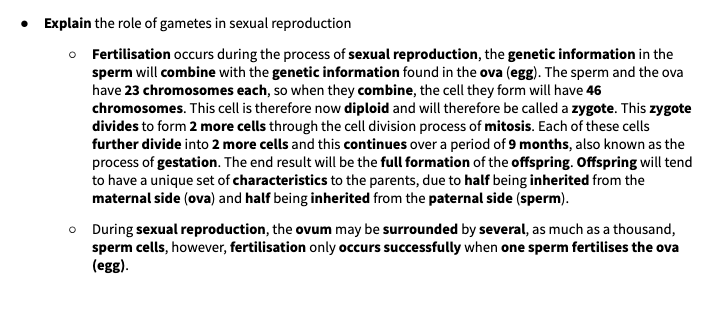
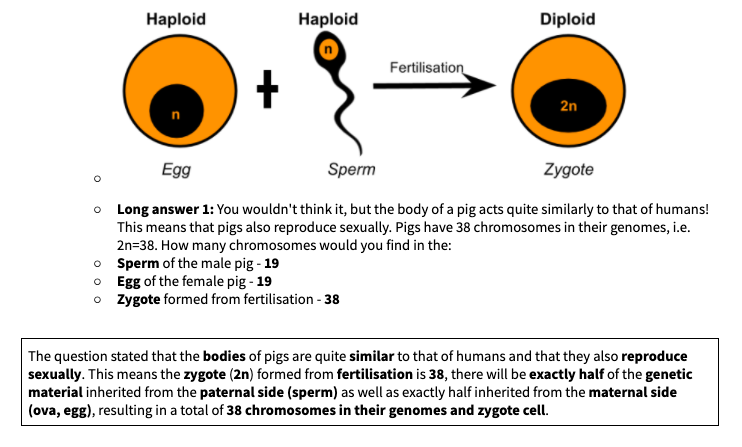
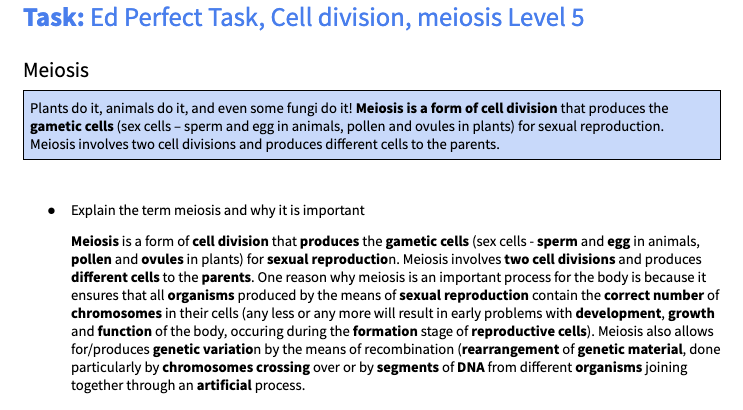
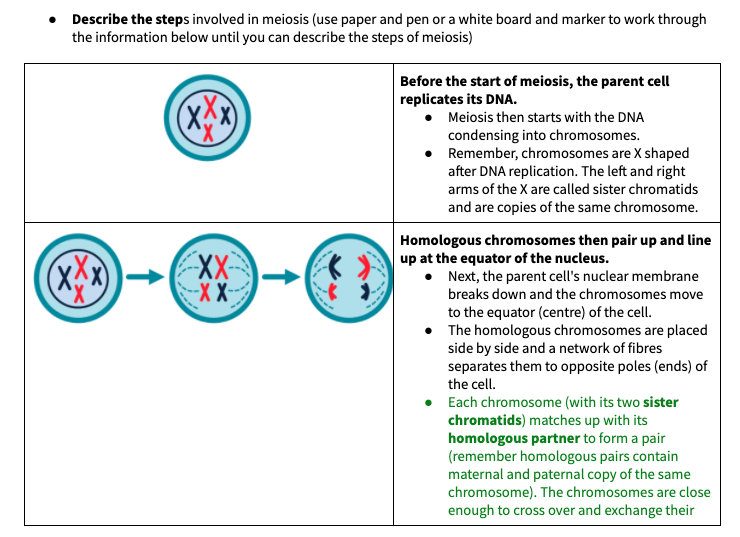
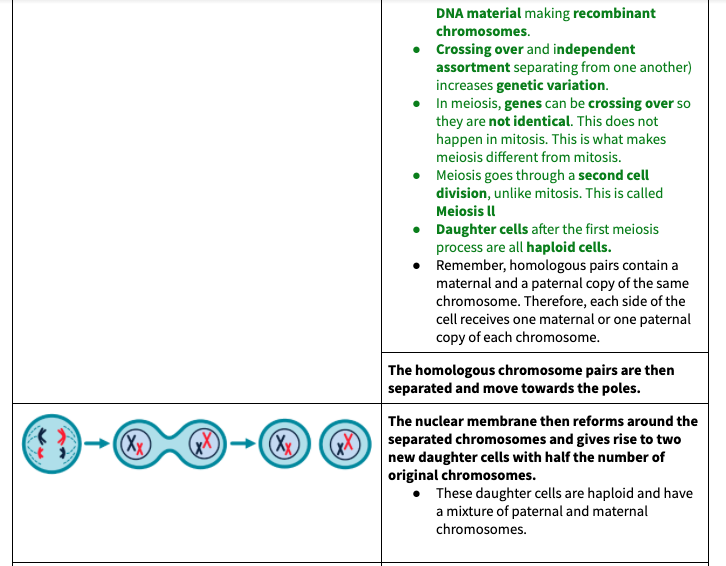
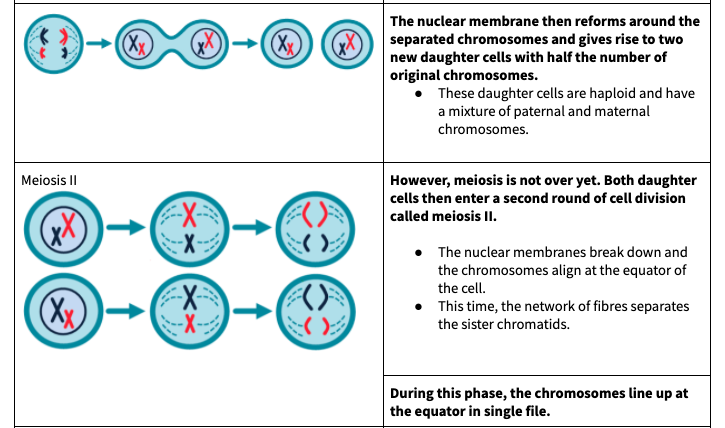
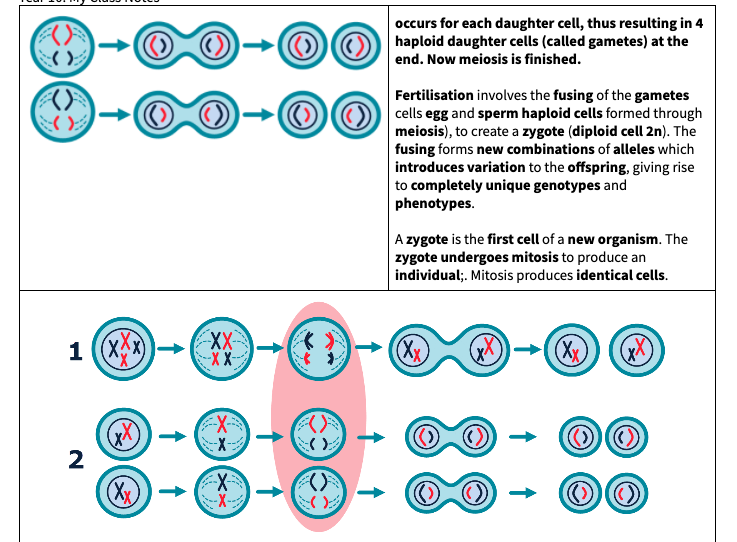





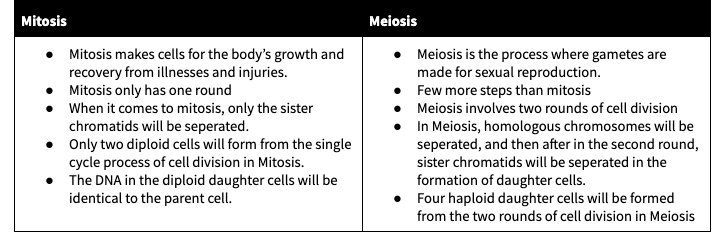
---------------------------------------------------------------------------------------------------------
EXPLORE / TŪHURA learning intentions:
- We are EXPLORING...the basic processes by which genetic information is passed from one generation to another.
FOCUS / ARONGA learning intentions:
- We are FOCUSING...our learning on developing an understanding of genetics and how information is passed from one generation to another.
- We are FOCUSING...our learning on defining, explaining, comparing and contrasting key genetic terms.
- We are FOCUSING...our transforming our knowledge to a digital learning platform.
REFLECT / WHAIWHAKAARO learning intentions:
- We are REFLECTING...at various stages to assess and critique our knowledge - more importantly to ensure we can make connections and understand the context with the view of highlighting issues/gaps in learning as early as possible.
-
Term 2 Week 9
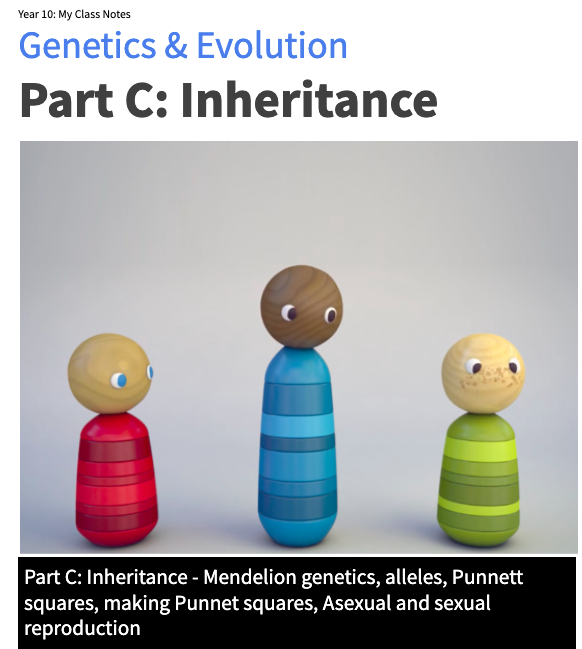
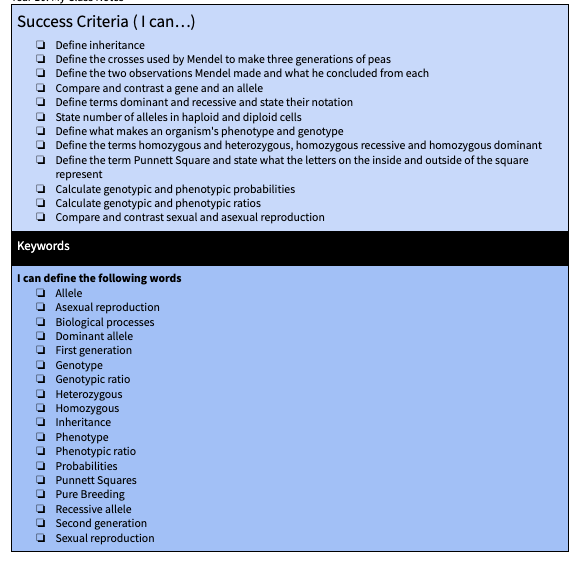
Learning intentions: See below
Success criteria: See above
Activities:
- Over the next few lessons you are going to work more independently to complete the tasks
- The work will not be posted online but you are required to complete Section D on the worksheet and Education Perfect
- You will also be required to complete the Punnett Square problem-solving activities
- Homework this week: To keep working on the above
-----------------------------------------------------------------------------------------------------------
EXPLORE / TŪHURA learning intentions:
- We are EXPLORING...the basic processes by which genetic information is passed from one generation to another.
FOCUS / ARONGA learning intentions:
- We are FOCUSING...our learning on developing an understanding of genetics and how information is passed from one generation to another.
- We are FOCUSING...our learning on defining, explaining, comparing and contrasting key genetic terms.
- We are FOCUSING...our transforming our knowledge to a digital learning platform.
REFLECT / WHAIWHAKAARO learning intentions:
- We are REFLECTING...at various stages to assess and critique our knowledge - more importantly to ensure we can make connections and understand the context with the view of highlighting issues/gaps in learning as early as possible.
-
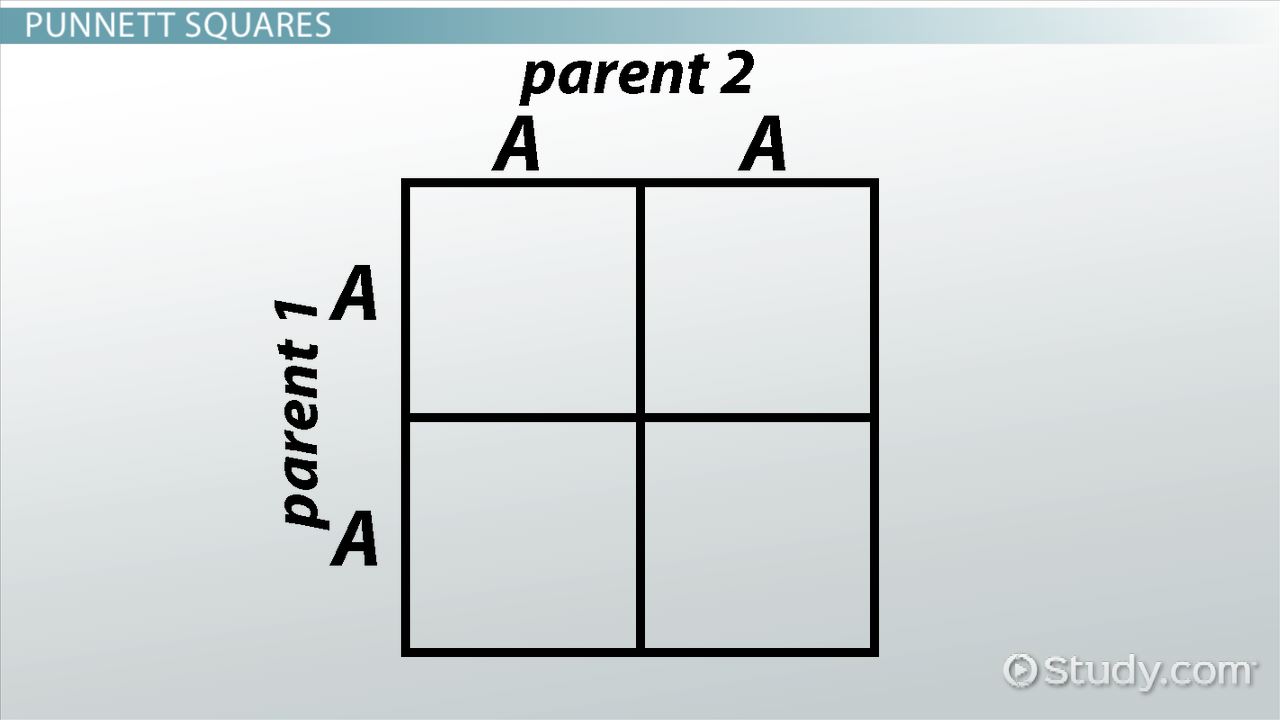
Term 2, Week 10
Learning intentions: See below
Success criteria: See above in the slide
Activities continued from the week prior
- Over the next few lessons you are going to work more independently to complete the tasks
- The work will not be posted online but you are required to complete Section D on the worksheet and Education Perfect
- You will also be required to complete the Punnett Square problem-solving activities
- Homework this week: To keep working on the above
-
Term 2: Week 11 Learning intentions:
Success criteria:
Activities: Assessment
- Complete any unfinished tasks on your document and Education Perfect
- Complete your Science Assessment

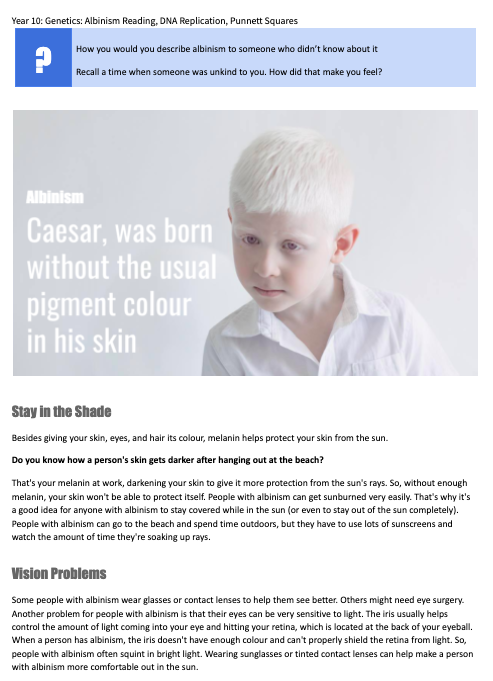


----------------------------------------------------------------------------------
PLAN & DO / WHAKAMAHI learning intentions:
- We are PLANNING...to create and publish a plasticine model of the process of DNA replication in relation to Albinism to demonstrate our learning. We will be collaborating in small teams. In addition to this, we will also be solving Punnett Square problems.
-
Term 2, Week 12 - Final week of the term
Activities:
- Finishing up any incomplete term work - Science Document and Education Perfect
- Finishing off experiments due to lockdown term 1
-
Welcome back to Term 3.
My name is Mrs. Lindsay and I will be continuing your science journey.
My contact details are alindsay@mhjc.school.nzThis term's context is Life Hacks.
This term, I will endeavour to prepare you for life outside of school and perhaps hone your understanding and skills in pool. It's a great trick to have up your sleeves!
We will start the term revising basic concepts of forces and motion, moving onto energy conversion. In the last couple of weeks, we will revisit anatomy and dissections if time allows.
I look forward to working with you all.
-
Hello fellow Scientists,
For the first 2 weeks of term, I will allow you to focus on your Science Fair assessment.
I have requested details of your Science Fair via Google classrooms so please ensure you communicate the bones of your project to me so that I can assist you.
If you are needing help, please contact me ASAP on alindsay@mhjc.school.nz so that we can get some progress happening. Even better, come talk to me. I am usually in my classroom.
-
Kia ora Scientists
Success Criteria:
1. Explore different types of forces
2. Explain forces in terms of Newton
3. Distinguish between contact and non-contact force
4. Able to measure forces using a force metre
5. Identify units that measure force
6. Explore the nature of gravity and how objects are affected by its presence
7. Distinguish between weight and mass
8. Understand weight as a force (weight force)
9. Calculate weight force correctly using newtons
10. Define gravity and its relationship with mass
11. Relate the 2 equations F = ma and F = mg
12. Explore what forces are acted upon an object
13. Understand that forces act in pairs
14. Distinguish between balanced and unbalanced forces
15. Identify several different forces on an object
16. Use vectors to demonstrate how different forces act upon stationary objects or objects in motion and its size
17. Draw vectors correctly, considering direction, size, and its centre of gravity
18. Calculate net force
19. Explain and give examples of scalar vs vector measurements
While the list looks long, many of these concepts you will have explored in previous years.Activities:
- Mass vs. weight practical and write up
- SCIPAD
- PHET simulations- various
- Brainpop quizzes and challenges
Further Learning:
All learning resources are posted on Google Classroom -
LEVEL 3 COVID LOCKDOWN
Stay home and stay safe
All learning is posted on Google Classrooms
-
Kia ora...
Welcome back!! Feels like we haven't seen each other in aaaaaaaaaaages but really is only been 2 weeks.
KA PAI to all who went on Google Classrooms and completed your Science Tasks.Success Criteria:
1. Observe all graphing conventions when drawing a graph
2. Use keywords to analyse a graph
3. Identify and describe reliability vs validity of an experiment
4. Write an effective conclusion for your experiment
5. Calculate and graph velocityActivities:
- Recap of all the forces and motion concepts we have covered thus far
- Using the data collected from the parachute experiment, draw a graph, write up a graph analysis and an effective conclusion, discussing reliability and validity
- Design and conduct an experiment that explores how height of a ramp affect the speed at which a toy car travels
- Complete a write up of the experiment
Further Learning:
All additional resources are posted on Google Classrooms -
Kia ora...
Success Criteria:
1. Define acceleration and differentiate it from speed and velocity
2. Calculate acceleration using a formula triangle (change in velocity = acceleration x time
3. Draw a speed time graph to calculate acceleration
4. Conclude and justify why mass does not affect acceleration whilst on earth (F= ma)Activities:
- Complete a time/speed/acceleration table using a formula triangle
- Design and conduct an experiment that investigates how balls of different masses accelerates down a ramp
- Complete a write up of acceleration rates of various mass of ball experiment, focusing on graphing skills, graph analysis, with an effective conclusion detailing limitations of the investigation
Further Learning:
All additional resources are posted on Google Classrooms -
Kia ora and a big welcome back to Term 4.
I hope you are all feeing refreshed after your 2 week break.
Due to COVID lockdowns, your science exams will be replaced by a one hour Common Assessment Tasks instead (aka CATs) on Monday 9th November, Session 4.
In preparation for these CATs, we will be developing our ability to interpret and communicate in science.
Success Criteria:
1. Increasing our understanding of vocabulary used in scientific literature
2. Developing our comprehension skills by describing and summarising what a scientific article is conveying
3. Extrapolating information from a scientific graph or diagram, and accurately communicating what is being conveyed
4. Summarise and describe a graph/diagram/picture using all the words from the title, as well as the text and numerical values in the scale, of the graph/diagram/picture.Activities:
- Reading scientific literature
- Analysing and communicating information conveyed in a scientific article by practising our writing skills with pen and paper (identify/describe/compare/summarise/inference)
Further Learning:
All resources will be handed out in class on paper as opposed to on devices. This is to mimic the CAT conditions.
-
Kia ora Scientists
Success Criteria:
1. Communicate a scientific experiment by writing a conventional lab report
2. Draw a graph with all scientific conventions accurately, and analyse the graph
3. Identify independent, dependent, and controls variables in an experiment
4. Write a conclusion by restating the aim, hypothesis, limitations, addressing limitations by increasing reliability, discuss validity and potential next steps
5. I can identify the different parts of a lung and describe how the lung "breathes" for us
6. I can conducted a lung dissection, and compare its similarities with the structure of a treeActivities:
- Catapult investigation
- Helicopter investigation
- Sheep lung dissection
Further Learning:
Most resources will be handed out in class on paper as opposed to on devices. This is to mimic the CAT conditions.
Some resources are posted on Google Classrooms -
Good luck for your CATs this week!
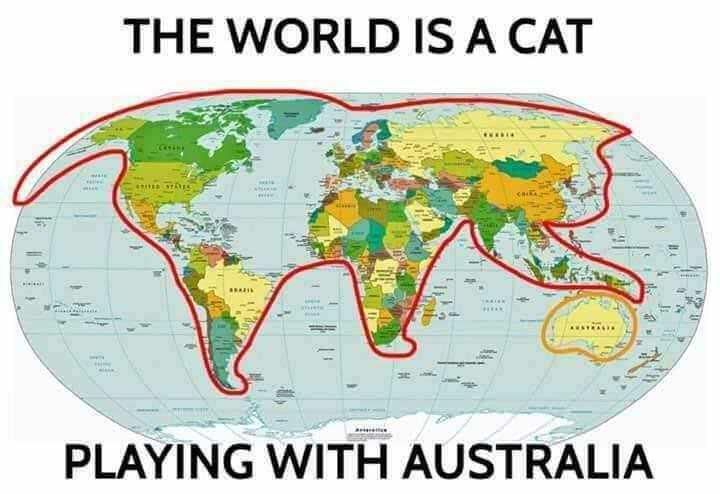
-
Kia ora...
I hope your CATs went well.

Success Criteria:
I can identify parts of an eyeball and describe its function
Activities:
- Eyeball theory
- Eyeball dissection
Further Learning:
See Google Classrooms -
Have fun at your Work Experience posts!


